| previous - contents - next |
The Card View allows you to look at the items in the current category as if they were placed on top of each other in a pack of cards. You can view both sides of each card (question and answer), and you can move from one card to another. The cards are ordered in the same way as in the Card List view. This chapter shows you how to work with your pack of cards in the following topics: |
 |
|
To flip the card, i.e. to switch between the question and answer side, tap one of the two Q/A buttons. To move to the previous or the next card, tap the left or right arrow at the bottom right corner of the screen. If an arrow is not present, it means that you have reached the top or the bottom of the category card pile. If there is more text on the card and it cannot fit the screen, you can scroll the card using the up and down arrows located in the bottom right corner as well. |
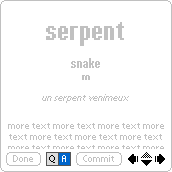 |
Scrolling speed and distance can be adjusted. Tap the top part of the card to open the menu and select Card / Scrolling to open the Card Scrolling options. |
 |
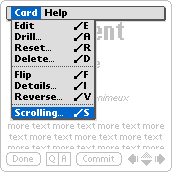 |
Card scrolling distance and speed can be set up separately for each direction (up and down). You can have a card to scroll down slowly and scroll up fast for instance. Distance and speed can be set from 1 (slow speed and short distance) to 10 (fast speed and long distance). To quickly set maximum and minimum values, tap the number inside the box. These card scrolling settings are also valid for drills and tests. You can also access this screen in drills and tests in the same way. |
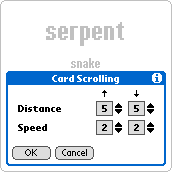 |
|
If you want to use the four hardware application buttons to launch their assigned applications instead, you need to tap some silkscreen button first, e.g. the Applications or the Menu buttons on the left of the Graffiti area. Of course, you can also leave the Card View screen. To flip the current card and switch between the question and answer side you can press the Up button. This also works in tests and drills. |
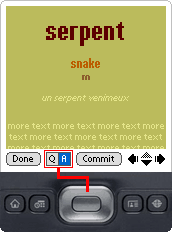 |
|||||
If there is more text on the card and it cannot fit the screen, you can scroll the card using the hardware Up and Down buttons as well. Card scrolling speed and distance can be adjusted using menu Card / Scrolling. |
 |
|||||
To move to the previous card in the pile press either button #1, button #3 or the Left button. You can hold the button down to move through the pile quickly. |
 |
|||||
To move to the next card in the pile press either button #2, button #4 or the Right button. You can hold the buttons down to move through the pile quickly. |
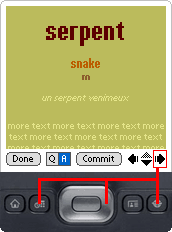 |
|||||
To commit a card to tell SuperMemo that you have learned this card and want to remember it, tap the Center button. |
 |
|||||
You can always see the Card Details screen by pressing the hardware Down button. If you want this screen to pop up automatically every time you proceed to another card, check the Pop-up Details box. |
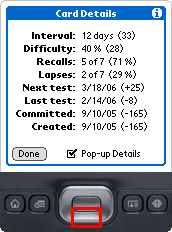 |
|||||
If you have checked the Pop-up Details box, you will always see the Card Details screen before the next card is shown. You can close this window by pressing buttons #1 to #4 or the Center button. |
 |
|
If you see a card that has not been committed into the learning system yet, it will have a Commit button. If the card is committed already, the button will not be visible. To commit the card to the learning system to tell SuperMemo that you have learned the card and want to remember it, just tap the Commit button. The button will disappear and from now on SuperMemo will take care that you do not forget the card. It will be automatically placed into drill for you and you will see it in a test in a day or two. |
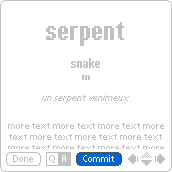 |
|
To edit the current card, all you have to do is to tap anywhere on the card. You will immediately get into the Card Edit screen. Another way to get to this screen is to use a menu command or to write an enter (aka return) Graffiti character, which is a move from the top right to the bottom left corner of the Graffiti area. To learn more about editing cards in the Card Edit screen see the Editing Cards chapter. |
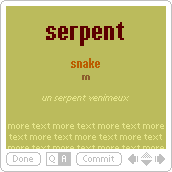 |
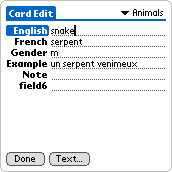 |
|
To open the menu use the menu button on your handheld. Depending on your handheld model, the menu button can be anything from a small icon in the status bar drawn on the screen to a key on a hardware keyboard. The menu button usually has a magnifying glass icon. You can also open the menu by tapping the top part of the card. The same menu is also accessible in tests and drills. |
 |
In this menu you will find six operations that apply to the currently displayed card, one that applies to all cards in the database (Reverse) and one that applies to all cards in all databases (Scrolling). These commands are:
|
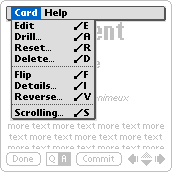 |
|
If you have an external hardware keyboard, you can control this screen with it. Below is a table that shows possible commands. Please note that due to different keyboard models, available keys and drivers, some commands may not work on all keyboards.
|
|
|
© MapleTop Software |
|
|